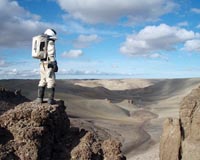 |
Cape Canaveral AFS FL (AFNS) Apr 26, 2010 Members of the 45th Space Wing launched a United Launch Alliance-built Atlas V Evolved Expendable Launch Vehicle carrying an X-37B Orbital Test Vehicle at 7:52 p.m. EDT April 22. The X-37B, making its first space flight, will provide a flexible space test platform to conduct various experiments and allow satellite sensors, subsystems, components and associated technology to be efficiently transported to and from the space environment where it will need to function. A number of new technologies will also be tested on the X-37B itself. "If these technologies on the vehicle prove to be as good as we estimate, it will make our access to space more responsive, perhaps cheaper, and push us in the vector toward being able to react to warfighter needs more quickly," said Gary Payton, the Air Force deputy undersecretary for space Programs. "This launch helps ensure that our warfighters will be provided the capabilities they need in the future," said Col. Andre Lovett, the 45th Space Wing vice commander and launch decision authority for the mission. "The 45th Space Wing (members are) proud to launch this historic mission and continue our commitment to assuring access to the high frontier." The mission marked a number of important firsts. "As the first U.S. unmanned re-entering space vehicle, the first of its kind, it has been remarkably easy to work with," said Lt. Col. Erik Bowman, the 45th Launch Support Squadron commander. "Processing and preparations went extremely smooth, and there were absolutely no delays in the vehicle processing. Overall there was great cooperation between the Air Force (officials) and industry teams of Boeing, (United Launch Alliance) and Astrotech, where we processed the spacecraft, to make sure everything went smoothly." The mission was also the first launch of an Atlas V with the 501 configuration, requiring no solid rocket motors, and the first launch in five years to involve a 5-meter class fairing, Colonel Bowman said. "This vehicle is light enough to launch without the solid rocket motors even with the larger fairing, making this a rather unique configuration." The X-37B program directly supports the Department of Defense's technology risk reduction efforts for new satellite systems. It will provide an "on-orbit laboratory" test environment to prove new technology and components before those technologies are committed to operational satellite programs.
related report "The X-37B has the potential to bring to space the flexibility that unmanned systems provide warfighters and combatant commanders today," said Dennis Muilenburg, president and CEO of Boeing Defense, Space and Security. "With the ability to be launched into space and then land on its own, the X-37B Orbital Test Vehicle is an example of the kind of innovation that Boeing has been doing for decades to advance aviation, space systems, and now unmanned systems. Close teamwork between the Air Force Rapid Capabilities Office, the United Launch Alliance Atlas team, and the 45th Space Wing at Cape Canaveral Air Force Station made this launch a success." The vehicle will be used to demonstrate a reliable, reusable unmanned space test platform for the Air Force. Program objectives include space experimentation, risk reduction, and concept-of-operations development for reusable space vehicle technologies. "The Orbital Test Vehicle combines the best of aircraft and spacecraft to enable flexible and responsive missions," said Paul Rusnock, Boeing vice president of Experimental Systems and program director for the X-37B. "This first flight will demonstrate the readiness of the X-37B to begin serving the Air Force as it continues to investigate ways to make space access more routine, affordable and responsive." Boeing's commitment to this space-based unmanned vehicle spans a decade and includes support to the Air Force Research Lab's X-40 program, NASA's X-37 program, and the Defense Advanced Research Projects Agency's X-37 approach, landing and test vehicle (ALTV) program.
Share This Article With Planet Earth
Related Links 45th Space Wing Space Tourism, Space Transport and Space Exploration News
 NASA, NSBRI Select Proposals To Support Health On Space Missions
NASA, NSBRI Select Proposals To Support Health On Space MissionsHouston TX (SPX) Apr 26, 2010 NASA's Human Research Program and the National Space Biomedical Research Institute, or NSBRI, of Houston will fund 11 proposals to help investigate questions about astronaut health and performance on future space exploration missions. The selected proposals, representing 10 institutions in eight states, will receive a total of almost $10 million over a three- to four-year period. The Human ... read more |
|
| The content herein, unless otherwise known to be public domain, are Copyright 1995-2010 - SpaceDaily. AFP and UPI Wire Stories are copyright Agence France-Presse and United Press International. ESA Portal Reports are copyright European Space Agency. All NASA sourced material is public domain. Additional copyrights may apply in whole or part to other bona fide parties. Advertising does not imply endorsement,agreement or approval of any opinions, statements or information provided by SpaceDaily on any Web page published or hosted by SpaceDaily. Privacy Statement |